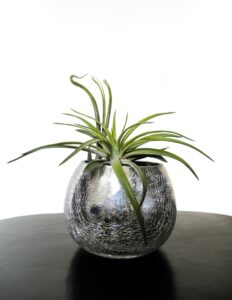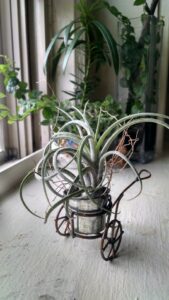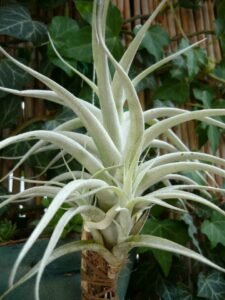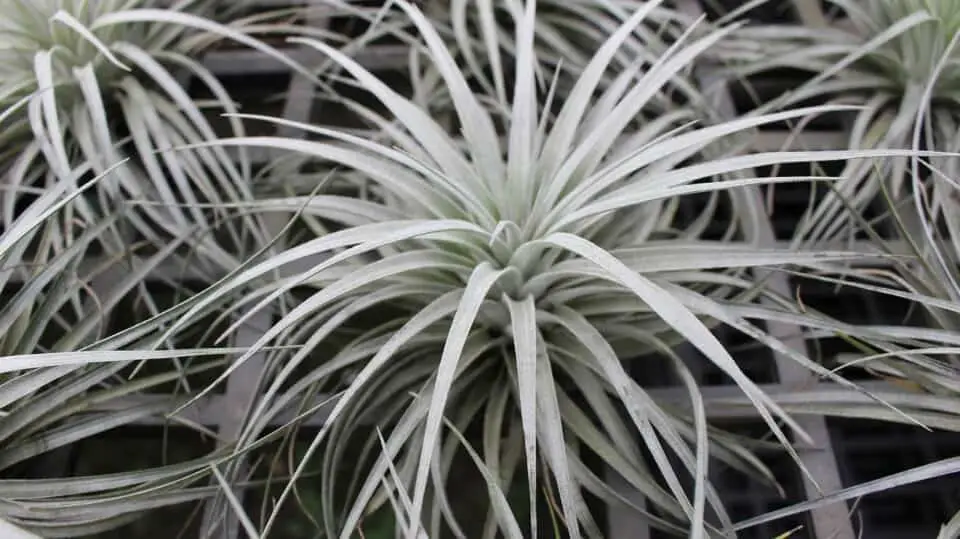Some links in the post are affiliate links and I get a commission from purchases made through some links found in the post.
Air plants (tillandsia) have become a big deal in gardening. And who can blame gardeners who love these species?
After all, you can mount them and go about your day, and they would still thrive. And the best thing? – most of them do not require potting mixes.
As the name suggests, they grow in the air, deriving their nutrients from the atmosphere. It makes it easy to place them in ways that bring out their natural beauty – as hanging fixtures, wall decorations, table centerpieces, etc.
But how big does an air plant get? Due to the large range of varieties of air plants, they can grow from 2 inches to 7 feet tall. But this question comes down to three important factors:
- The species you choose,
- Where the air plant thrives (based on its natural habitat), and
- The kind of care you give your plant
Due to the large range of varieites of air plants, they can grow from 2 inches to 7 feet tall.
As a result, I cannot give you a one-size-fits-all answer. See below for more on how big these plants can get and how you can get yours to grow even bigger:
How Big Can an Air Plant Get?
 Tillandsia is a genus, not a specific plant as one may think. And under this genus, you find a range of species that do not grow in soil.
Tillandsia is a genus, not a specific plant as one may think. And under this genus, you find a range of species that do not grow in soil.
Instead, they get what they need from their leaves which draw nutrients and moisture from the air. So, when I talk about an air plant, it could be any plant in this genus.
It could be any of the more than 600 species that fall under this umbrella. Thus, it would not be ideal to give you an exact range of how big your air plant can get.
But you can expect your plant to grow about two inches to seven feet tall. Most varieties average about five inches in size.
However, to help you get a better idea of just how different the air plant species are, please refer to the growth spurts below:
Small Air Plant Species
Suppose you want a plant that does not get unmanageable over time. You can consider any of these species:
The Rubra
This plant belongs to the Ionantha family, which has some of the smallest air plants you will ever come across.
No matter how much care you give such a plant, it remains compact during its lifecycle. On average, the plant achieves one to two inches in height. They are great as accessories as they boast beautiful foliage.
The Fuego
If you do not have much room in your home or office and want a plant that barely takes up space, this would be it.
It gives rise to bright red leaves that add character to any room for weeks. And the most interesting bit? – This plant averages one inch in height and diameter.
The Andreana
How about a green porcupine in your home? That’s what this plant reminds gardeners of- a porcupine, only that, in this case, you can approach it without getting torn apart by spikes. This plant grows to about two to three inches.
The Mexican
This species also belongs to the Ionantha family. On average, it reaches about one to two inches in height and circumference.
The plant is quite hardy and can withstand prolonged periods of neglect. So, if you are a certified plant killer, this might be the match for you.
The Scaposa
If you give this species the right conditions (as we will later discuss), it can grow up to three inches tall.
But if not, it will likely hit the one-inch mark, and that will be it. It makes for a great houseplant choice due to its soft green leaves.
The Bandensis
Here is yet another popular small air plant species which takes on the shape of a sea urchin. It grows to about one to two inches on average with deep purple foliage.
The Big Air Plant Species
Did you know that some air plants can be as big as 6 or 7 feet in the wild? That’s about 1.8 to 2.1 meters!
If you could achieve that indoors, you would have something akin to a greenhouse.
While such heights may not be feasible in your circumstances, below are some of the tallest air plant species you can consider for your space:
The Xerographica
How does 2 inches sound? Not good enough? Well, how about a whopping 36 inches? That’s 0.9 meters of foliage sprawling all over your space.
And as the plant spreads, its broad leaves do the same, creating a beautiful pattern over your wall, ceiling, you name it. That’s why these plants are so common in the gardening world.
I should also add that they are quite hardy and would work even for a budding beginner who is not quite sure where to start.
And if you want this plant to grow even bigger, give it the right care and wait for its inflorescences, each of which can measure 3 feet!
The Capitala Giant White
From the name, you can tell that this is not a small plant by any means. This collector’s item features silvery leaves coupled with yellow-flowering spikes that are a sight to behold.
While they are slow growers, they reach an average of 0.35 meters in height and girth. So, your patience is well worth it in the end. If you want them to grow faster, incorporate artificial lights.
The Brachycaulos

This attractive species with cascading foliage is particularly easy to maintain. All you need is to keep it away from the direct sun and soak it at least twice a week, and the rest will take care of itself.
In the end, it should reach about 0.25 meters in height and circumference. It can grow much bigger in the right conditions.
The options are quite many. So, what is your choice going to be?
You may also like: What is the Ideal Humidity for an Air Plant?
How To Get Your Air Plant to Grow Bigger
Air plants grow at a slow pace. But that’s not to say that you cannot speed up this process or push your plant to reach a bigger height.
Even so, you should keep in mind that you cannot fight a plant’s nature. If its limit is two feet in indoor conditions, that’s how far it can grow.
So, it’s always nice to be realistic and avoid pushing it too much. Below are the essential care practices you should work into your air plant maintenance schedule:
1) Understand its native habitat
I have talked a lot about the right conditions for each species. But what are the right conditions? While air plants belong to the same species, they are adapted to different growing conditions.
Some are xeric while the others are mesic. And what works for the xeric plants will not necessarily be okay for the mesic types.
Take humidity as an example. Xeric plants prefer ranges above 65%, while mesic plants can withstand anything from 50%.
So, understand what applies to your specific plant and go with it. In general, the following conditions should act as a helpful guide:
2) Provide the air plant with sufficient light
Most air plants do not enjoy being in direct light. Thus, you should leave the plants in bright and indirect light. Ideally, this should be towards an east or west-facing window.
The plant should be near and not against the window to avoid getting hit by direct sun rays. Again, the placement depends on the plant type.
Xeric plants can tolerate more sun than mesic types. If you can’t offer your plant adequate natural light, you can supplement the light with artificial light.
3) Water the plant regularly
Air plants absorb moisture from the air. Thus, their form of watering is quite different from that of plants in potting mixes.
When watering the plant, you can soak them in water or mist the plant. To soak the plant, leave its roots in water for ten minutes, then place it on a towel to allow the roots to dry for about an hour.
That ensures the roots remain free of water and don’t rot. Mesic plants are needier when it comes to watering and will need you to soak them once a week.
Xeric plants can do with watering once every two weeks. If you opt to mist the plant, do so about three to seven times a week, depending on how hot the climate is.
Please note that while misting is effective in watering the plant and increasing the humidity ranges, you should still soak the plant occasionally.
4) Ensure the temperatures do not fall below 50 degrees Fahrenheit
 Air plants do best in humid conditions. And the hotter the air is, the more humid it gets.
Air plants do best in humid conditions. And the hotter the air is, the more humid it gets.
Lower temperatures hurt the plant and can damage its foliage, hampering its ability to make food and survive. Unfortunately, you cannot undo such foliage damage.
Also, watch out for pests. It’s easier to keep them away by using neem oil on the air plant.
Final Thoughts
Most air plants don’t get to live past five years. Thus, enjoy your air plant while it lasts and give it the best care possible to see how beautiful it can be. Happy Gardening!
Before you go, here are some more related articles I encourage you to read below to help solve more of your gardening issues:
8 Air Plant Problems & How to Fix Them
5 Reasons Your Air Plant is Turning Brown & How to Fix it

